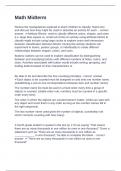-
1. Exam (elaborations) - 2.5 measure of position questions with complete solution 2024/2025
-
2. Exam (elaborations) - 172 final exam question and answers rated a+ 2024/2025
-
3. Exam (elaborations) - 172 final exam hondros term 3 question and answers 100% correct 2024/2025
-
4. Exam (elaborations) - 172 final exam question and answers already passed 2024/2025
-
5. Exam (elaborations) - 172 quiz 2 question and answers already passed 2024/2025
-
6. Exam (elaborations) - 172 quiz 3 lol question and answers verified to pass 2024/2025
-
7. Exam (elaborations) - Abeka consumer math test 5 question and answers verified to pass 2024/2025
-
8. Exam (elaborations) - Algebra 1 question and answers correctly solved 2024/2025
-
9. Exam (elaborations) - Core math question and answers correctly solved 2024/2025
-
10. Exam (elaborations) - Cset math questions with complete solution 2024/2025
-
11. Exam (elaborations) - End of third grade math assessment question and answers 100% correct 2024/2025
-
12. Exam (elaborations) - Final exam math question and answers already passed 2024/2025
-
13. Exam (elaborations) - Grade 5 question and answers already passed 2024/2025
-
14. Exam (elaborations) - Hesi math section question and answers verified to pass 2024/2025
-
15. Exam (elaborations) - Hist of math pt 3 question and answers verified to pass 2024/2025
-
16. Exam (elaborations) - K-6 mathematics question and answers correctly solved 2024/2025
-
17. Exam (elaborations) - Lesson vocab for 13 questions with complete solution 2024/2025
-
18. Exam (elaborations) - Ma 172 test 2 question and answers already passed 2024/2025
-
19. Exam (elaborations) - Ma 172 test 3 question and answers verified to pass 2024/2025
-
20. Exam (elaborations) - Mat 172 question and answers verified to pass 2024/2025
-
21. Exam (elaborations) - Mat 172 question and answers correctly solved 2024/2025
-
22. Exam (elaborations) - Mat 172 ch 7 equations question and answers verified to pass 2024/2025
-
23. Exam (elaborations) - Mat 172 exam 2 question and answers correctly solved 2024/2025
-
24. Exam (elaborations) - Mat 172 midterm study guide questions with complete solution 2024/2025
-
25. Exam (elaborations) - Mat 172 test 4 equations question and answers rated a+ 2024/2025
-
26. Exam (elaborations) - Mat 172 test one question and answers already passed 2024/2025
-
27. Exam (elaborations) - Mat 172 test questions with complete solution 2024/2025
-
28. Exam (elaborations) - Mat 172 trig functions question and answers rated a+ 2024/2025
-
29. Exam (elaborations) - Mat 172 trig identities question and answers 100% correct 2024/2025
-
30. Exam (elaborations) - Mat 172 unit 2 study set question and answers verified to pass 2024/2025
-
31. Exam (elaborations) - Mat 172 question and answers verified to pass 2024/2025
-
32. Exam (elaborations) - Mat question and answers correctly solved 2024/2025
-
33. Exam (elaborations) - Mat question and answers rated a+ 2024/2025
-
34. Exam (elaborations) - Mat question and answers correctly solved 2024/2025
-
35. Exam (elaborations) - Mat172 finite math question and answers 100% correct 2024/2025
-
36. Exam (elaborations) - Math 172 question and answers verified to pass 2024/2025
-
37. Exam (elaborations) - Math 172 exam 1 question and answers already passed 2024/2025
-
38. Exam (elaborations) - Math 172 exam 1. question and answers verified to pass 2024/2025
-
39. Exam (elaborations) - Math 172 final question and answers correctly solved 2024/2025
-
40. Exam (elaborations) - Math 172 set 3 questions with complete solution 2024/2025
-
41. Exam (elaborations) - Math 172 questions with complete solution 2024/2025
-
42. Exam (elaborations) - Math midterm question and answers rated a+ 2024/2025
-
43. Exam (elaborations) - Math number devil question and answers 100% correct 2024/2025
-
44. Exam (elaborations) - Math questions and answers already passed 2024/2025
-
45. Exam (elaborations) - Math question and answers correctly solved 2024/2025
-
46. Exam (elaborations) - Math question and answers already passed 2024/2025
-
47. Exam (elaborations) - Mathematics instruction question and answers verified to pass 2024/2025
-
48. Exam (elaborations) - Precalculus 172 chapter 6 question and answers rated a+ 2024/2025
-
49. Exam (elaborations) - Sampling and estimation question and answers 100% correct 2024/2025
-
50. Exam (elaborations) - Solve systems of linear equations question and answers already passed 2024/2025
-
51. Exam (elaborations) - Test unit 1 question and answers verified to pass 2024/2025
-
Show more




